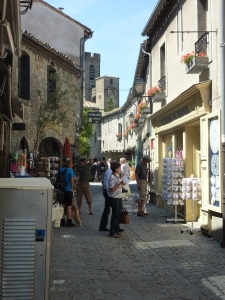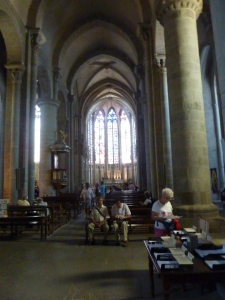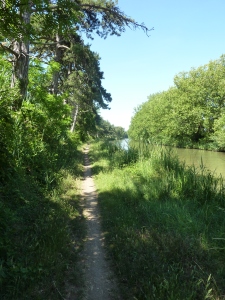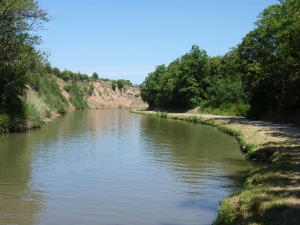I prepared to leave Castelnaudary at nine after a fairly nondescript breakfast. There was another cyclist in the garage preparing to leave when I went to collect my bike. He was a ski-instructor who apparently spent half of his year in Chambéry and the other half in Argelès. He was going along the canal in the opposite direction to me, having set off from Port La Nouvelle near Narbonne. We swapped stories about the condition of the tow-path. He told me I could expect it to get progressively worse from Castelnaudary and then better once I got on to the Canal de la Robine. He turned out to be exactly the same age as me, so we compared notes, with much cackling, about creaking joints, the effects of falling off the bike in wet weather, and the condition of the lower back. I then set off. In bright morning sunshine, the town looked quite different. The streets, too, were busy. There was a market that stretched down the whole length of the Cours de la République. I almost regretted not being able to stay a little longer, since the market looked worth a visit.
Outside Castelnaudary, the tow-path started off reasonably enough, but it was clearly getting rougher with large tree roots and stones a particular menace, since the ground was still wet from yesterday's rain and wet pebbles and tree roots form very slippery, angled surfaces that can fling you from your bike without a second's notice; and the water's edge is never far away. My destination for this evening was the village of Puichéric, west of Carcassonne and more specifically, the Domaine des Fontanelles, my chambres d'hôte. The weather promised perfect conditions for visiting the old city and I was determined that today wouldn't be the boring slog that yesterday had been.
The tow path dried out rapidly and turned out to be reasonably good. I made rapid progress and was in Carcassonne for lunch time. Once out of the cutting in which the canal approaches the town, I made straight for the old city across the old bridge.
The climb to the old city was less stiff that I expected. The problem was not the ascent, but the quantity of tourist coaches manoeuvring to offload their human cargo. The place was already heaving with visitors of all nationalities. I was glad I'd come here outside of the tourist season, because in the high season it must be intolerable. I was also glad I hadn't come by road.
I went through the main gates of the old town, pushing my bike now on account of the dense crowds. I decided to forego a visit of the castle since leaving my bike, however well-locked, would require me to leave my baggage unattended.
I went around most of the city in the space between the inner and outer ramparts, an area unaccountably empty of tourists.
Then at around one thirty, I stopped at a restaurant, deciding that I couldn't possibly leave the area without sampling the local cassoulet. It was pleasant enough sitting in the street devouring the stuff, but it continued to make its presence felt for hours after.
I always wondered why Carcassonne had two distinct centres, why the old fortified city on its rocky outcrop was so obviously separate from the newer town below. Carcassonne is clearly two towns, rather than an old heart surrounded by more modern districts. The reason is this: the presence of so many heretical Cathars in the old city in the early thirteenth century brought down the wrath of the crusading Pope Innocent III and the military attentions of his enforcer, Simon de Montfort. The population which had enjoyed the protection of Raymond of Toulouse, was driven out of the town, but allowed to set up an alternative settlement down below. This alternative settlement remained completely separate from the old city and gradually outstripped the latter in economic importance.
The old city is heavily restored and the quality of the restoration by Viollet-le-Duc (the chap who stuck incongruous bits and bobs on the cathedral of Notre-Dame in Paris in the nineteenth century) has given rise to much controversy.
I spent four hours in the city before continuing my journey to Puichéric. The tow-path, once out of Carcassonne soon got much worse than it had been so far. It became very rough and very narrow,
and then even narrower.
The ride along the tow-path remained nonetheless an enormous pleasure and the tree-roots and stones were not as troublesome as they might have been had the weather been wet. I was conscious that as a canal-side traveller I was using a route that had been the equivalent of the motorway in a previous age. When I though of the present-day motorised tourists with their tedious, stressful journeys on large trunk roads, their perpetual struggles with crowds of their peers, their endless peregrinations through featureless suburbs, it struck me with great force that I was privileged. To have been able to arrive without fuss, without crowds and without traffic at the very centre of an important city such as Carcassonne, and to have been able to leave in the same way, was a special privilege, and a privilege, moreover, that had cost me nothing at all, except a little positive physical effort. And all of this had been possible under my own steam, while adding nothing to the pollution of the atmosphere (cassoulet notwithstanding) and doing myself a great physical favour in the process. To add to this, bits of the Canal du Midi in this area are outstandingly pretty, and, compared to yesterday's ride, there was plenty to see.
I arrived at the turn-off for Puichéric at around six. But I went blundering off into the village which was about three kilometres from the canal, thinking that my chambres d'hôtewould be there. It turned out that I had passed the Domaine des Fontanelles without realising it and had added a five kilometre circle to my journey for nothing. The house was literally yards from the tow-path, though very little suggested that it was there. When I had finally located the place [see: http://www.fontanelles.fr/spip.php?rubrique1] it turned out that the property had changed hands as a result of the illness of the previous owner, with whom I had made my booking. Nevertheless, the present couple, a Frenchman and a Polish lady, were very welcoming and after a shower and an unexpected encounter when I came face to forked tongue with a snake in my bedroom (just a grass snake!) I joined the three other couples who were also cycling along the canal. At least that's what I assumed. As it turned out, the two French couples had gone in for a very traditional arrangement: the men were doing the cycling, while the ladies went ahead in their van to prepare meals at strategic stopping-points. The two fellows in question were quite unabashed, and the ladies, though grumbling a little at their support role, seemed reasonably accepting of the situation , stressing that they did the usual tourist stuff between meals. I couldn't imagine doing such a thing myself, even though a suggestion to try a very similar arrangement had been made to me before I left England.
The dinner was a very jolly affair with oven-baked rougets and ratatouille, preceded bycrudités and followed by four varieties of local cheese and then a fruit salad. The meal was liberally arrosé with local wines, including a surprising unbottled Minervois from a local producer . Two very large decanters of this stuff disappeared down appreciative throats and fired up the conversation which turned around anecdotes about the canal and its tow-path. Pascal Gutierrez the present manager of the place was an agreeable host, if a little loud, and his partner, Eva from Poland, had a great deal to say about the organic food and wine and the generally wholesome eco-friendly practices of the place. She went on a bit too much about her devotion to produits bio; but by the time we had drunk the several decanters dry, she was barely coherent and no-one seemed to notice any more. I went off to my room, conscious that the grass-snake was probably still sharing it with me. But that didn't interfere with an excellent night's sleep.



















No comments:
Post a Comment